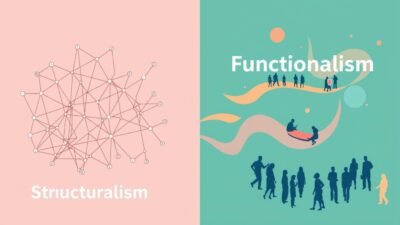Introduction
In the realm of social theory, two paradigms stand out for their profound influence on how we understand society: Structuralism and Functionalism. These frameworks offer distinct lenses through which to analyze social phenomena, shaping disciplines from sociology to anthropology and beyond. But what exactly do these theories entail, and how do they differ?
In this comprehensive article, we will delve deep into the intricacies of Structuralism vs. Functionalism, unpacking their foundational principles, key theorists, and real-world applications. By the end, you will not only grasp the nuances of these theories but also appreciate their relevance in contemporary social analysis.
Why This Matters
Understanding Structuralism and Functionalism is essential for anyone interested in social sciences. These theories provide the groundwork for analyzing societal structures, cultural norms, and human behavior. Whether you’re a student, a researcher, or simply a curious mind, this exploration will equip you with valuable insights into the mechanisms that govern our social world.
Structuralism: A Closer Look
What is Structuralism?
Structuralism emerged in the early 20th century as a reaction against the individualistic approaches that dominated social sciences. It posits that human culture can be understood by examining the underlying structures that shape social phenomena. These structures are often linguistic, social, or cultural, and they operate beneath the surface of observable behaviors.
Key Theorists
Ferdinand de Saussure: Often regarded as the father of Structuralism, Saussure emphasized the importance of language as a system of signs. He argued that meaning is derived not from individual words but from the relationships between them.
- Claude Lévi-Strauss: A prominent anthropologist, Lévi-Strauss applied Structuralism to the study of myths and kinship systems. He believed that universal structures underlie all human cultures, revealing the shared cognitive patterns of humanity.
Core Principles
- Language as Structure: Language is not merely a tool for communication; it is a structure that shapes our thoughts and perceptions.
- Binary Oppositions: Structuralists often analyze cultural phenomena through binary oppositions (e.g., nature vs. culture, raw vs. cooked), which reveal the underlying structures of meaning.
- Interconnectedness: Individual elements of culture cannot be understood in isolation; they must be examined within the context of the larger system.
Real-World Applications
Structuralism has been influential in various fields, including:
- Literary Criticism: Analyzing texts through the lens of structural relationships and conventions.
- Anthropology: Understanding cultural practices and beliefs as part of a larger system of meaning.
Functionalism: A Comprehensive Overview
What is Functionalism?
Functionalism, on the other hand, focuses on the functions that various elements of society serve. It views society as a complex system whose parts work together to promote stability and social order. This perspective emphasizes the role of social institutions in maintaining the equilibrium of society.
Key Theorists
Émile Durkheim: Often considered the father of sociology, Durkheim argued that social facts (norms, values, structures) are crucial for understanding social order. He believed that each part of society serves a specific function that contributes to the overall stability.
- Talcott Parsons: Parsons expanded on Durkheim’s ideas, proposing that social systems consist of interrelated parts that function together. He introduced the concept of the "AGIL" framework, which outlines four essential functions of social systems: Adaptation, Goal attainment, Integration, and Latency.
Core Principles
- Social Cohesion: Functionalism emphasizes the importance of social cohesion and the role of institutions in fostering unity.
- Equilibrium: Society tends to maintain a state of equilibrium, where changes in one part of the system will lead to adjustments in others.
- Functionality: Every social structure has a purpose, whether it be to fulfill needs, maintain order, or promote socialization.
Real-World Applications
Functionalism has been applied in various areas, including:
- Education: Understanding how educational institutions contribute to socialization and skill development.
- Health Care: Analyzing the role of health care systems in maintaining societal well-being.
Structuralism vs. Functionalism: Key Differences
Focus of Analysis
- Structuralism: Concentrates on the underlying structures that shape cultural and social phenomena.
- Functionalism: Examines the functions of social institutions and their contributions to societal stability.
Methodological Approaches
- Structuralism: Often employs qualitative methods, focusing on textual analysis and cultural artifacts.
- Functionalism: Typically uses quantitative methods, emphasizing statistical analysis and empirical research.
View of Society
- Structuralism: Views society as a complex web of interrelated structures that shape human behavior.
- Functionalism: Sees society as a cohesive system where each part serves a specific function.
Implications for Social Change
- Structuralism: Suggests that change occurs through shifts in underlying structures and cultural meanings.
- Functionalism: Proposes that change is often resisted to maintain social equilibrium; however, it acknowledges that gradual change can occur.
Visual Representation of Structuralism vs. Functionalism
Table: Key Differences
| Aspect | Structuralism | Functionalism |
|---|---|---|
| Focus | Underlying structures | Functions of social institutions |
| Methodology | Qualitative analysis | Quantitative analysis |
| View of Society | Complex web of structures | Cohesive system |
| Change Dynamics | Shifts in structures | Resistance to change |
Engaging with Structuralism and Functionalism
Practical Applications
Understanding both Structuralism and Functionalism can enhance your analytical skills in various fields. Here are some actionable takeaways:
- Critical Thinking: Use Structuralism to dissect cultural texts, identifying underlying meanings and structures.
- Social Analysis: Apply Functionalism to evaluate the roles of institutions in your community, assessing their contributions to social stability.
- Interdisciplinary Insights: Combine insights from both theories to develop a more nuanced understanding of social phenomena.
Case Study: Education Systems
Consider how both theories can be applied to analyze education systems:
- Structuralism: Examine the language used in educational policies and curricula to uncover underlying biases and cultural narratives.
- Functionalism: Assess how educational institutions contribute to socialization, skill development, and the overall functioning of society.
Conclusion
In summary, the exploration of Structuralism vs. Functionalism: Unpacking the Foundations of Social Theory reveals two distinct yet complementary approaches to understanding society. While Structuralism emphasizes the underlying structures that shape human behavior, Functionalism focuses on the roles and functions of social institutions in maintaining societal stability.
By grasping these theories, you empower yourself to analyze social phenomena critically and appreciate the complexities of human culture. Whether you’re a student, researcher, or simply an inquisitive mind, the insights gained from this exploration can enhance your understanding of the social world.
Motivational Insight
As you continue your journey in social theory, remember that the world is a tapestry of interconnected structures and functions. Embrace the complexity, and let your curiosity guide you toward deeper understanding and meaningful engagement with the world around you.
FAQs
1. What is the main difference between Structuralism and Functionalism?
Structuralism focuses on the underlying structures that shape culture, while Functionalism examines the functions of social institutions in maintaining societal stability.
2. Who are the key theorists associated with Structuralism and Functionalism?
Key theorists for Structuralism include Ferdinand de Saussure and Claude Lévi-Strauss, while Émile Durkheim and Talcott Parsons are prominent figures in Functionalism.
3. How can I apply these theories in real life?
You can apply Structuralism to analyze cultural texts and Functionalism to evaluate the roles of institutions in your community.
4. Are Structuralism and Functionalism still relevant today?
Yes, both theories continue to influence contemporary social analysis and provide valuable frameworks for understanding complex social phenomena.
5. How do these theories view social change?
Structuralism suggests that change occurs through shifts in underlying structures, while Functionalism posits that change is often resisted to maintain social equilibrium.
By understanding the nuances of Structuralism vs. Functionalism: Unpacking the Foundations of Social Theory, you can engage more deeply with the social world and contribute to meaningful discussions in the field. Happy exploring! 😊





